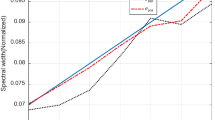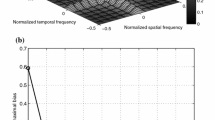Abstract
An important issue in low-altitude wind-shear detection is to estimate the wind speed of wind field. In this paper, a novel method for wind speed estimation with airborne phased array radar is proposed by combining space time adaptive processing and compressive sensing. The proposed method is able to achieve accurate wind speed estimate in the condition of limited number of sampling pulses, as demonstrated by numerical examples.






Similar content being viewed by others
References
Baxa, E. G. Jr., & Ernest, G. (1993). Windshear detection radar signal processing studies. Final technical report no. 18, 16 November 1988–31 October 1993, Clemson University, SC. Department of Electrical and Computer Engineering, (Vol. 1).
Bringi, V. N., & Chandrasekar, V. (2001). Polarimetric Doppler weather radar: Principles and applications. Cambridge: Cambridge University Press.
Britt, C., Harrah, S., & Grittenden, L. (1993). Microburst hazard detection performance of the NASA experimental windshear radar system. In Aircraft design, systems, and operations meeting. doi:10.2514/6.1993-3943.
Cai, T. T., & Wang, L. (2011). Orthogonal matching pursuit for sparse signal recovery with noise. IEEE Transactions on Information Theory, 57(7), 4680–4688.
Candès, E. J., Romberg, J., & Tao, T. (2006). Robust uncertainty principles: Exact signal reconstruction from highly incomplete frequency information. IEEE Transactions on Information Theory, 52(2), 489–509.
David, D. L., Tsaig, Y., Drori, I., & Starck, J.-L. (2012). Sparse solution of underdetermined systems of linear equations by stagewise orthogonal matching pursuit. IEEE Transactions on Information Theory, 58(2), 1094–1121.
Donoho, L. (2006). Compressed sensing. IEEE Transactions on Information Theory, 52(4), 1289–1306.
Doviak, R. J., & Zrnic, D. S. (1993). Doppler radar and weather observations. USA: Dover Publications, Inc.
Gilbert, A. C., Guha, S., Indyk, P., Muthukrishnan, S., & Strauss, M. (2002). Near-optimal sparse fourier representations via sampling. In Proceedings of the thiry-fourth annual ACM symposium on theory of computing, ACM, (pp. 152–161).
Gilbert, A. C., Muthukrishnan, S., & Strauss, M. (2005). Improved time bounds for near-optimal sparse fourier representations. In International society for optics and photonics (pp. 59141A–59141A).
Klemm, R. (2002). Principles of space-time adaptive processing. UK: IET Publishers.
Lapierre, F. D., Ries, P., & Verly, J. G. (2009). Foundation for mitigating range dependence in radar space-time adaptive processing. IET Radar, Sonar & Navigation, 3(1), 18–29.
Li, H., Zhang, B., Wu, R., Lu, X., & Han, Y. (2015). Wind speed estimation for low-altitude windshear based on space-time apes. In Radar conference (RadarCon), 2015 IEEE (pp. 0521–0526).
Needell, D., & Tropp, J. A. (2009). Cosamp: Iterative signal recovery from incomplete and inaccurate samples. Applied and Computational Harmonic Analysis, 26(3), 301–321.
Needell, D., & Vershynin, R. (2010). Signal recovery from incomplete and inaccurate measurements via regularized orthogonal matching pursuit. IEEE Journal of Selected Topics in Signal Processing, 4(2), 310–316.
Paramore, S., Woodell, D. L., & Barber, S. (2006). Airborne weather radar system and radar display, September 19 2006, US Patent 7,109,913.
Prünte, L. (2010). Application of compressed sensing to SAR/GMTI-data. In 2010 8th European Conference on Synthetic Aperture Radar (EUSAR), (pp. 1–4). VDE.
Tropp, A. J., & Gilbert, A. C. (2007). Signal recovery from random measurements via orthogonal matching pursuit. IEEE Transactions on Information Theory, 53(12), 4655–4666.
Valaee, S., Champagne, B., & Kabal, P. (1995). Parametric localization of distributed sources. IEEE Transactions on Signal Processing, 43(9), 2144–2153.
Varadarajan, V., & Krolik, J. L. (2006). Joint space-time interpolation for distorted linear and bistatic array geometries. IEEE Transactions on Signal Processing, 54(3), 848–860.
Wang, Y., & Peng, Y. (2000). Space-time adaptive processing. Beijing: Tsinghua University Press.
Wu, R., Biao, Z., & Li, H. (2015). Wind speed estimation for low-altitude windshear based on space-time adaptive processing. Jounal of Electronics and Information Technology, 37(3), 631–336.
Wu, R. L., Xiaoguang, H. L., & Han, Y. (2014). Overview on airborne forward-looking weather radar with windshear detection capability. Journal of Data Acquisition and Processing, 29(4), 476–507.
Xiao, Y. (1993). Principle of Fight in Amospheric Dsturbances. Beijing: National Defend Industy Press.
Yao, H. (2013). Research on parameter estimation method for distributed sources. PhD Dissertation, PLA Information Engineering University, Zhenzhou, China.
Acknowledgments
This work was supported by National Nature Science Foundation of China (NSFC) under Grants 61471365, 61571442 and 61231017, National University’s Basic Research Foundation of China under Grant No. 3122015B002. The work is also supported by the Foundation for Sky Young Scholars of Civil Aviation University of China.
Author information
Authors and Affiliations
Corresponding author
Rights and permissions
About this article
Cite this article
Li, H., Zhou, M., Guo, Q. et al. Compressive sensing-based wind speed estimation for low-altitude wind-shear with airborne phased array radar. Multidim Syst Sign Process 29, 719–732 (2018). https://doi.org/10.1007/s11045-016-0448-6
Received:
Revised:
Accepted:
Published:
Issue Date:
DOI: https://doi.org/10.1007/s11045-016-0448-6




